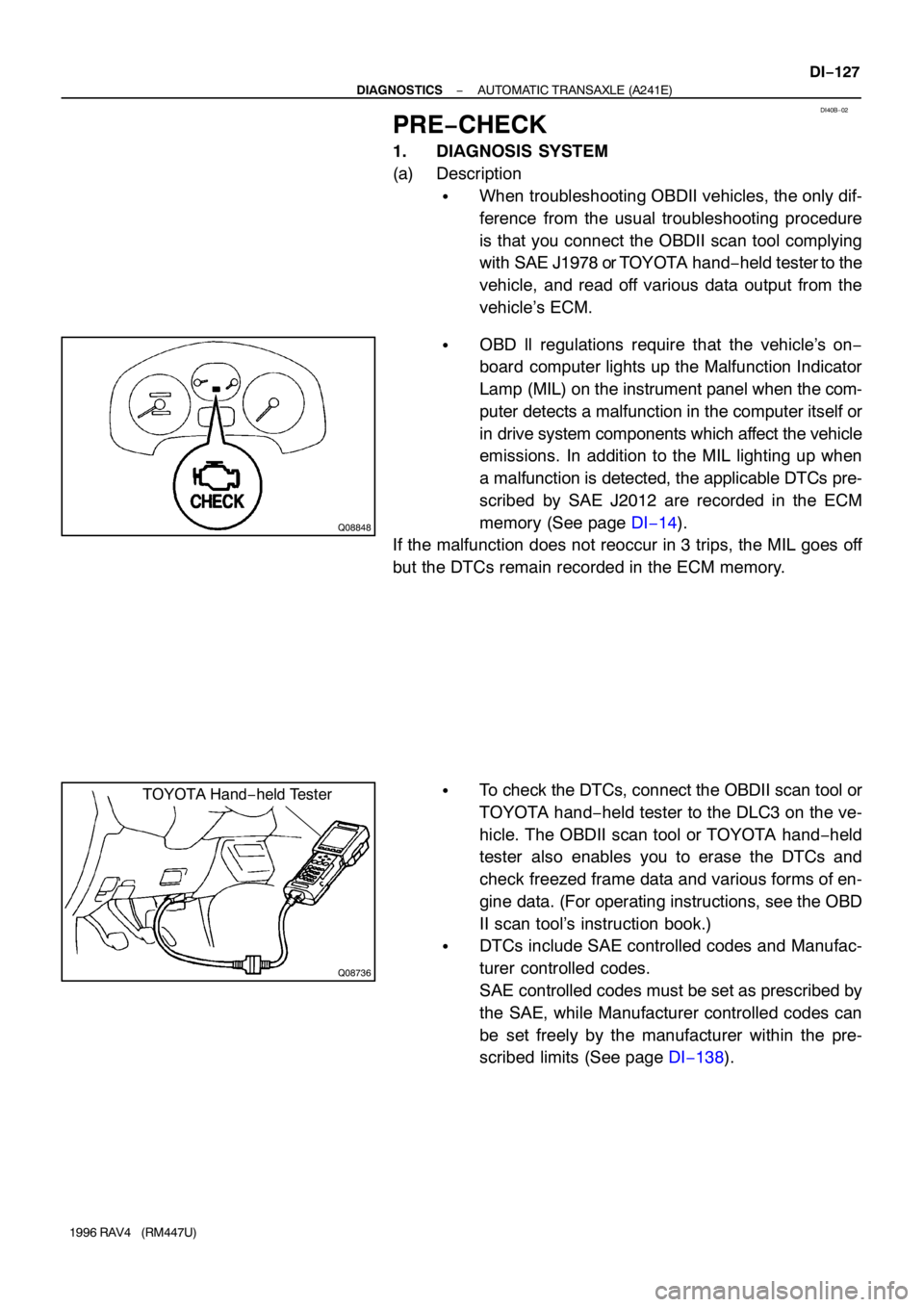Page 323 of 1354

DI3Z7−01
FI0534
S01354
TOYOTA
Hand−Held Tester
− DIAGNOSTICSENGINE
DI−3
1996 RAV4 (RM447U)
PRE−CHECK
1. DIAGNOSIS SYSTEM
(a) Description
�When troubleshooting OBDII vehicles, the only dif-
ference from the usual troubleshooting procedure
is that you connect to the vehicle the OBDII scan
tool complying with SAE J1978 or TOYOTA hand−
held tester, and read off various data output from
the vehicle’s ECM.
�OBDII regulations require that the vehicle’s on−
board computer lights up the Malfunction Indicator
Light (MIL) on the instrument panel when the com-
puter detects a malfunction in the computer itself on
in drive system components which affect vehicle
emissions. In addition to the MIL lighting up when
a malfunction is detected, the applicable Diagnostic
Trouble Code (DTC) prescribed by SAE J2012 are
recorded in the ECM memory (See page DI−14).
�If the malfunction does not recur in 3 trips, the MIL
goes off but the DTC remain recorded in the ECM
memory.
�To check the DTC, connect the OBDII scan tool or
TOYOTA hand−held tester to Data Link Connector
3 (DLC3) on the vehicle. The OBDII scan tool or
TOYOTA hand−held tester also enables you to
erase the DTC and check freezed frame data and
various forms of engine data. (For operating instruc-
tions, see the OBDII scan tool’s instruction book.)
�DTC include SAE controlled codes and Manufac-
ture controlled codes.
�SAE controlled codes must be set as prescribed by
the SAE, while Manufacturer controlled codes can
be set freely by the manufacturer within the pre-
scribed limits (See DTC chart on page DI−14).
�The diagnosis system operates in normal mode
during normal vehicle use. It also has a check mode
for technicians to simulate malfunction symptoms
and troubleshoot. Most DTC use 2 trip detection
logic* to prevent erroneous detection and ensure
thorough malfunction detection.
Page 447 of 1354

DI40B−02
Q08848
Q08736
TOYOTA Hand−held Tester
− DIAGNOSTICSAUTOMATIC TRANSAXLE (A241E)
DI−127
1996 RAV4 (RM447U)
PRE−CHECK
1. DIAGNOSIS SYSTEM
(a) Description
�When troubleshooting OBDII vehicles, the only dif-
ference from the usual troubleshooting procedure
is that you connect the OBDII scan tool complying
with SAE J1978 or TOYOTA hand−held tester to the
vehicle, and read off various data output from the
vehicle’s ECM.
�OBD ll regulations require that the vehicle’s on−
board computer lights up the Malfunction Indicator
Lamp (MIL) on the instrument panel when the com-
puter detects a malfunction in the computer itself or
in drive system components which affect the vehicle
emissions. In addition to the MIL lighting up when
a malfunction is detected, the applicable DTCs pre-
scribed by SAE J2012 are recorded in the ECM
memory (See page DI−14).
If the malfunction does not reoccur in 3 trips, the MIL goes off
but the DTCs remain recorded in the ECM memory.
�To check the DTCs, connect the OBDII scan tool or
TOYOTA hand−held tester to the DLC3 on the ve-
hicle. The OBDII scan tool or TOYOTA hand−held
tester also enables you to erase the DTCs and
check freezed frame data and various forms of en-
gine data. (For operating instructions, see the OBD
II scan tool’s instruction book.)
�DTCs include SAE controlled codes and Manufac-
turer controlled codes.
SAE controlled codes must be set as prescribed by
the SAE, while Manufacturer controlled codes can
be set freely by the manufacturer within the pre-
scribed limits (See page DI−138).
Page 493 of 1354

DI40T−02
Q08848
Q08736
TOYOTA Hand−held Tester
− DIAGNOSTICSAUTOMATIC TRANSAXLE (A540H)
DI−173
1996 RAV4 (RM447U)
PRE−CHECK
1. DIAGNOSIS SYSTEM
(a) Description.
�When troubleshooting OBDII vehicles, the only dif-
ference from the usual troubleshooting procedure
is that you connect the OBDII scan tool complying
with SAE J1978 or TOYOTA hand−held tester to the
vehicle, and read off various data output from the
vehicle’s ECM.
�OBD ll regulations require that the vehicle’s on−
board computer lights up the Malfunction Indicator
Lamp (MIL) on the instrument panel when the com-
puter detects a malfunction in the computer itself or
in drive system components which affect the vehicle
emissions. In addition to the MIL lighting up when
a malfunction is detected, the applicable DTCs pre-
scribed by SAE J2012 are recorded in the ECM
memory (See page DI−14).
If the malfunction does not reoccur in 3 trips, the MIL goes off
but the DTCs remain recorded in the ECM memory.
�To check the DTCs, connect the OBDII scan tool or
TOYOTA hand−held tester to the DLC3 on the ve-
hicle. The OBDII scan tool or TOYOTA hand−held
tester also enables you to erase the DTCs and
check freezed frame data and various forms of en-
gine data. (For operating instructions, see the OB-
DII scan tool’s instruction book.)
�DTCs include SAE controlled codes and Manufac-
turer controlled codes.SAE controlled codes must
be set as prescribed by the SAE, while Manufactur-
er controlled codes can be set freely by the
manufacturer within the prescribed limits (See page
DI−189).